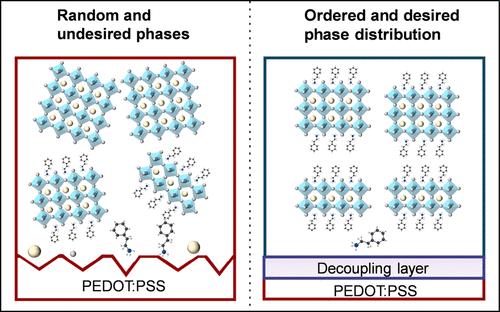当前位置:
X-MOL 学术
›
ACS Energy Lett.
›
论文详情
Our official English website, www.x-mol.net, welcomes your
feedback! (Note: you will need to create a separate account there.)
Interfacial Decoupling Layer Enabled Low-n Phase Enrichment for Blue Quasi-2D Perovskites
ACS Energy Letters ( IF 19.3 ) Pub Date : 2024-11-18 , DOI: 10.1021/acsenergylett.4c02351 Jie Dong, Wenqiang Yang, Kayoung Cho, Jeong Hyun Jung, Huanyu Zhou, Eojin Yoon, Hao Chen, Hyeon-Dong Lee, Seung Hyeon Jo, Jae-Man Park, Qingsen Zeng, Tingyu Long, Kyung Yeon Jang, Seong Eui Chang, Chan-Yul Park, Min-Jun Sung, Joo Sung Kim, Hyeree Kim, Dandan Song, Zheng Xu, JaeHong Park, Jeong-Yun Sun, Tae-Woo Lee
ACS Energy Letters ( IF 19.3 ) Pub Date : 2024-11-18 , DOI: 10.1021/acsenergylett.4c02351 Jie Dong, Wenqiang Yang, Kayoung Cho, Jeong Hyun Jung, Huanyu Zhou, Eojin Yoon, Hao Chen, Hyeon-Dong Lee, Seung Hyeon Jo, Jae-Man Park, Qingsen Zeng, Tingyu Long, Kyung Yeon Jang, Seong Eui Chang, Chan-Yul Park, Min-Jun Sung, Joo Sung Kim, Hyeree Kim, Dandan Song, Zheng Xu, JaeHong Park, Jeong-Yun Sun, Tae-Woo Lee

|
The random n-monolayer phase distributions and impurity phases impose challenges to achieving blue-emission quasi-2D perovskite light emitting diodes (PeLEDs), and their formation mechanism is unclear. Here, we uncover the reasons behind the phase formation and distribution in blue-emission quasi-2D perovskites by probing into the molecular interactions at the buried interface between substrates and perovskites and propose a mechanistic model to depict the film formation process. Furthermore, an interfacial decoupling layer, perfluorinated ionomer, was employed to successfully mitigate the negative impact of substrates on the phase formation and distribution of blue-emission quasi-2D perovskites, resulting in an ordered phase distribution and a reduction of undesired phases. Besides, this interfacial layer effectively suppressed the nonradiative recombination losses, leading to enhanced photoluminescence quantum yield from 12.71% to 60.13% and notable blue shift (∼10 nm) even without incorporating Cl ions. As a result, blue PeLEDs based on this strategy achieved an external quantum efficiency reaching 12.09%.
中文翻译:

界面解耦层实现蓝色准 2D 钙钛矿的低 n 相富集
随机的 n 单层相分布和杂质相对实现蓝色发射准 2D 钙钛矿发光二极管 (PeLED) 提出了挑战,其形成机制尚不清楚。在这里,我们通过探测衬底和钙钛矿之间埋藏界面处的分子相互作用,揭示了蓝色发射准二维钙钛矿中相形成和分布背后的原因,并提出了一个机理模型来描述薄膜形成过程。此外,采用界面解耦层,全氟离聚物,成功地减轻了衬底对蓝色发射准 2D 钙钛矿相形成和分布的负面影响,从而产生有序的相分布并减少不需要的相。此外,该界面层有效地抑制了非辐射复合损失,即使不掺入 Cl 离子,光致发光量子产率也从 12.71% 提高到 60.13%,并显着蓝移 (∼10 nm)。结果,基于此策略的蓝色 PeLED 实现了 12.09% 的外部量子效率。
更新日期:2024-11-18
中文翻译:

界面解耦层实现蓝色准 2D 钙钛矿的低 n 相富集
随机的 n 单层相分布和杂质相对实现蓝色发射准 2D 钙钛矿发光二极管 (PeLED) 提出了挑战,其形成机制尚不清楚。在这里,我们通过探测衬底和钙钛矿之间埋藏界面处的分子相互作用,揭示了蓝色发射准二维钙钛矿中相形成和分布背后的原因,并提出了一个机理模型来描述薄膜形成过程。此外,采用界面解耦层,全氟离聚物,成功地减轻了衬底对蓝色发射准 2D 钙钛矿相形成和分布的负面影响,从而产生有序的相分布并减少不需要的相。此外,该界面层有效地抑制了非辐射复合损失,即使不掺入 Cl 离子,光致发光量子产率也从 12.71% 提高到 60.13%,并显着蓝移 (∼10 nm)。结果,基于此策略的蓝色 PeLED 实现了 12.09% 的外部量子效率。


















































 京公网安备 11010802027423号
京公网安备 11010802027423号